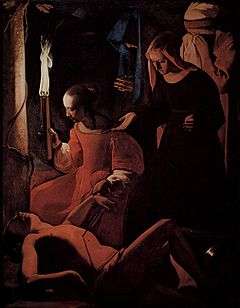Saint Sebastian
Saint Sebastian (c. AD 256 – 288) was an early Christian saint and martyr. According to traditional belief, he was killed during the Roman emperor Diocletian's persecution of Christians. He was initially tied to a post or tree and shot with arrows, though this did not kill him. He was, according to tradition, rescued and healed by Saint Irene of Rome, which became a popular subject in 17th-century painting. In all versions of the story, shortly after his recovery he went to Diocletian to warn him about his sins, and as a result was clubbed to death.[1][2] He is venerated in the Roman Catholic Church and the Orthodox Church.
Saint Sebastian | |
|---|---|
 Martyrdom of Saint Sebastian, by Il Sodoma, c. 1525 | |
| Captain of the Praetorian Guard Roman Soldier, Healer and Martyr | |
| Born | c. AD 256 |
| Died | c. AD 288 (aged c. 32) |
| Venerated in | Roman Catholic Church Eastern Orthodox Church Oriental Orthodoxy Anglicanism Aglipayan Church |
| Major shrine | San Sebastiano fuori le mura Italy |
| Feast | January 20 (Roman Catholic), December 18 (Orthodox) |
| Attributes | Tied to a post, pillar or a tree, shot by arrows |
| Patronage | Soldiers, plague-stricken, archers, Holy Christian death, Persecuted Christians, athletes, Negombo, Roman Catholic Diocese of Tarlac, Roman Catholic Diocese of Bacolod, Rio de Janeiro, Lumban, Laguna |
The oldest record of the details of Sebastian's martyrdom is a sermon on Psalm 118 by 4th-century bishop Ambrose of Milan (Saint Ambrose), in his sermon on . Ambrose stated that Sebastian came from Milan and that he was already venerated there at that time. Saint Sebastian is a popular male saint, especially today among athletes.[3][4] In historical times, he was regarded as a saint with a special ability to intercede to protect from plague, and devotion to him greatly increased when plague was active.
Life

The first surviving account of Sebastian's life and death is the Passio Sancti Sebastiani, long thought to have been written by Ambrose of Milan in the 4th century, but now regarded as a 5th-century account by an unknown author. This includes the "two martyrdoms", and the care by Irene in between, and other details that remained part of the story.[5]
According to Sebastian's 18th-century entry in Acta Sanctorum,[6] still attributed to Ambrose by the 17th-century hagiographer Jean Bolland, and the briefer account in the 14th-century Legenda Aurea, he was a man of Gallia Narbonensis who was taught in Mediolanum (Milan). In 283, Sebastian entered the army in Rome under Emperor Carinus to assist the martyrs. Because of his courage he became one of the captains of the Praetorian Guards under Diocletian and Maximian, who were unaware that he was a Christian.[2]
According to tradition, Marcus and Marcellian were twin brothers from a distinguished family and were deacons. Both brothers married, and they resided in Rome with their wives and children. The brothers refused to sacrifice to the Roman gods and were arrested. They were visited by their parents Tranquillinus and Martia in prison, who attempted to persuade them to renounce Christianity. Sebastian succeeded in converting Tranquillinus and Martia, as well as Saint Tiburtius, the son of Chromatius, the local prefect. Another official, Nicostratus, and his wife Zoe were also converted. It has been said that Zoe had been a mute for six years; however, she made known to Sebastian her desire to be converted to Christianity. As soon as she had, her speech returned to her. Nicostratus then brought the rest of the prisoners; these 16 persons were converted by Sebastian.[7]
Chromatius and Tiburtius converted; Chromatius set all of his prisoners free from jail, resigned his position, and retired to the country in Campania. Marcus and Marcellian, after being concealed by a Christian named Castulus, were later martyred, as were Nicostratus, Zoe, and Tiburtius.[8]
Martyrdom

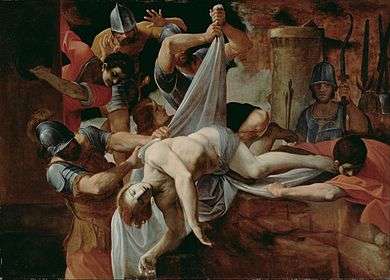
Sebastian had prudently concealed his faith, but in 286 it was detected. Diocletian reproached him for his supposed betrayal, and he commanded him to be led to a field and there to be bound to a stake so that certain archers from Mauritania would shoot arrows at him. "And the archers shot at him till he was as full of arrows as an urchin[Note 1] is full of pricks, and thus left him there for dead."[13] Miraculously, the arrows did not kill him. The widow of Castulus, Irene of Rome, went to retrieve his body to bury it, and discovered he was still alive. She brought him back to her house and nursed him back to health.[2]
Sebastian later stood by a staircase where the emperor was to pass and harangued Diocletian for his cruelties against Christians. This freedom of speech, and from a person whom he supposed to have been dead, greatly astonished the emperor; but recovering from his surprise, he gave orders for Sebastian to be seized and beaten to death with cudgels, and his body thrown into the common sewer. A pious lady, named Lucina, admonished by the martyr in a vision, privately removed the body and buried it in the catacombs at the entrance of the cemetery of Calixtus,[8] where now stands the Basilica of St. Sebastian.[2]
Location of remains
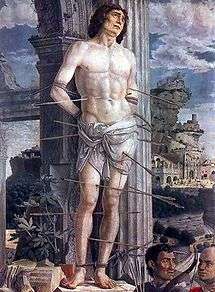
Remains reputed to be those of Sebastian are housed in Rome in the Basilica Apostolorum, built by Pope Damasus I in 367 on the site of the provisional tomb of Saints Peter and Paul. The church, today called San Sebastiano fuori le mura, was rebuilt in the 1610s under the patronage of Scipione Borghese.
St. Ado, Eginard, Sigebert, and other contemporary authors relate that, in the reign of Louis Debonnair, Pope Eugenius II gave the body of St. Sebastian to Hilduin, Abbot of St. Denys, who brought it into France, and it was deposited at Saint Medard Abbey, at Soissons, on 8 December, in 826.[8]
Sebastian's cranium was brought to the town of Ebersberg (Germany) in 934. A Benedictine abbey was founded there and became one of the most important pilgrimage sites in southern Germany.[14] It is said the silver-encased cranium was used as a cup in which to present wine to the faithful during the feast of Saint Sebastian.[15]
- Reliquary of Saint Sebastian in Ebersberg
- Silver sculpture from 1450
- The cranium
As protector against plague

The belief that Saint Sebastian was a defense against the plague was a medieval addition to his reputation, which largely accounts for the enormous increase in his importance in the Late Middle Ages. The connection of the martyr shot with arrows with the plague is not an intuitive one, however. In Greco-Roman myth, Apollo, the archer god, at times destroys his enemies by shooting plague-arrows from the heavens, but is also the deliverer from pestilence; the figure of Sebastian Christianizes this folkloric association. Similar metaphors for divine displeasure occur in the Hebrew Bible.
The hopeful example of Sebastian being able to recover from his "first martyrdom" (or "sagittation", as it is sometimes called) was also relevant, and the arrow-wounds can resemble the buboes that were symptoms of bubonic plague. Visually, "the arrow wounds call to God for mercy to us, as the symptoms of the unfirm call for pity from the passerby", as Molanus put it.[17]
The chronicler Paul the Deacon relates that, in 680, Rome was freed from a raging pestilence by him. The Golden Legend transmits the episode of a great plague that afflicted the Lombards in the time of King Gumburt, which was stopped by the erection of an altar in honor of Sebastian in the Church of Saint Peter in the Province of Pavia.
In art and literature
Art
The earliest known representation of Sebastian is a mosaic in the Basilica of Sant'Apollinare Nuovo (Ravenna, Italy) dated between 527 and 565.[18] The right lateral wall of the basilica contains large mosaics representing a procession of 26 martyrs, led by Saint Martin and including Sebastian. The martyrs are represented in Byzantine style, lacking any individuality, and all have identical expressions.
Another early representation is in a mosaic in the Church of San Pietro in Vincoli in Rome, probably made in the year 682. It shows a grown, bearded man in court dress but contains no trace of an arrow.[19] The archers and arrows begin to appear by 1000, and ever since have been far more commonly shown than the actual moment of his death by clubbing, so that there is a popular misperception that this is how he died.[20]
As protector of potential plague victims (a connection popularized by the Golden Legend[21]) and soldiers, Sebastian occupied an important place in the popular medieval mind. He was among the most frequently depicted of all saints by Late Gothic and Renaissance artists, in the period after the Black Death.[22] The opportunity to show a semi-nude young male, often in a contorted pose, also made Sebastian a favorite subject.[23] His shooting with arrows was the subject of the largest engraving by the Master of the Playing Cards in the 1430s, when there were few other current subjects with male nudes other than Christ. Sebastian appears in many other prints and paintings, although this was due to his popularity with the faithful. Among many others, Botticelli, Perugino, Titian, Pollaiuolo, Giovanni Bellini, Guido Reni (who painted the subject seven times), Mantegna (three times), Hans Memling, Gerrit van Honthorst, Luca Signorelli, El Greco, Honoré Daumier, John Singer Sargent and Louise Bourgeois all painted Saint Sebastians. An early work by the sculptor Gianlorenzo Bernini is of Saint Sebastian.
The saint is ordinarily depicted as a handsome youth pierced by arrows. Predella scenes when required often depicted his arrest, confrontation with the Emperor, and final beheading. The illustration in the infobox is the Saint Sebastian of Il Sodoma, at the Pitti Palace, Florence.
A mainly 17th-century subject, though found in predella scenes as early as the 15th century,[24] was Saint Sebastian Tended by Saint Irene, painted by Georges de La Tour, Trophime Bigot (four times), Jusepe de Ribera, Hendrick ter Brugghen (in perhaps his masterpiece)[25] and others. This may have been a deliberate attempt by the Church to get away from the single nude subject, which is already recorded in Vasari as sometimes arousing inappropriate thoughts among female and male churchgoers.[26] The Baroque artists usually treated it as a nocturnal chiaroscuro scene, illuminated by a single candle, torch or lantern, in the style fashionable in the first half of the 17th century. There exist several cycles depicting the life of Saint Sebastian. Among them are the frescos in the "Basilica di San Sebastiano" of Acireale (Italy) with paintings by Pietro Paolo Vasta.
Egon Schiele, an Austrian Expressionist artist, painted a self-portrait as Saint Sebastian in 1915.[27]
Literature and fiction
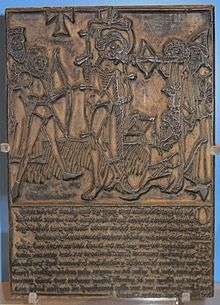
In 1911, the Italian playwright Gabriele d'Annunzio in conjunction with Claude Debussy produced Le Martyre de saint Sébastien. The American composer Gian Carlo Menotti composed a ballet score for a Ballets Russes production which was first given in 1944. In his novella Death in Venice, Thomas Mann hails the "Sebastian-Figure" as the supreme emblem of Apollonian beauty, that is, the artistry of differentiated forms; beauty as measured by discipline, proportion, and luminous distinctions. This allusion to Saint Sebastian's suffering, associated with the writerly professionalism of the novella's protagonist, Gustav Aschenbach, provides a model for the "heroism born of weakness", which characterizes poise amidst agonizing torment and plain acceptance of one's fate as, beyond mere patience and passivity, a stylized achievement and artistic triumph.
In George Orwell's futuristic novel Nineteen Eighty-Four, the protagonist Winston Smith, at the time he is not aware she actually loves him and hates the Party, is said to have dreams of ravishing the girl Julia, and having her pierced through with arrows like Saint Sebastian.
Sebastian's death was depicted in the 1949 film Fabiola, in which he was played by Massimo Girotti.[28] In 1976, the British director Derek Jarman made a film, Sebastiane, which caused controversy in its treatment of the martyr as a "homosexual icon", according to a number of critics reflecting a subtext perceptible in the imagery since the Renaissance.[1] Also in 1976, in the American horror film Carrie, a figure of Saint Sebastian (commonly misconstrued as a figure of the crucified Christ) appears in Carrie's prayer closet.[29]
The April, 1968 issue of Esquire Magazine depicts photographer George Lois and art director Carl Fischer's photo of boxer, Mohammad Ali simulating the iconography of a bound Saint Sebastian pierced by arrows.
Additionally in 1976, a depiction of Saint Sebastian in a fresco restoration in an isolated Italian village is the central motif and cryptic mystery of the giallo horror film The House with Laughing Windows.[30]
In her 1965 story "Everything That Rises Must Converge", Flannery O’Connor's character Julian feels as if he were the martyr while taking his mother to "reducing" classes at the Y.
In The Godfather Part III (1990), Michael Corleone is awarded the "Order of Saint Sebastian".[31]
In 1997, the eighth episode of the second season of the television series Millennium, the protagonists search for the hand of Saint Sebastian.[32]
In 2007, artist Damien Hirst presented Saint Sebastian, Exquisite Pain from his Natural History series. The piece depicts a cow in formaldehyde, bound in metal cable and shot with arrows.[33]
British pop band Alt-J's video for "Hunger of the Pine" contains references to the story of Saint Sebastian's death, adapted to fit the lyrics of the song. Tarsem Singh's video for the R.E.M. song "Losing My Religion" makes use of imagery of St. Sebastian, drawing particular inspiration from paintings by Guido Reni[34] and Caravaggio.[35] The indie folk band the Mountain Goats have a song called "Hail, St. Sebastian" that makes reference to his life.[36] Scottish musician Momus has a song "Lucky like St Sebastian", featuring on his 1986 debut album Circus Maximus.
The 2013–2018 Canadian drama series Forgive Me centres on a priest haunted by recurring visions of Saint Sebastian.[37]
Patronage
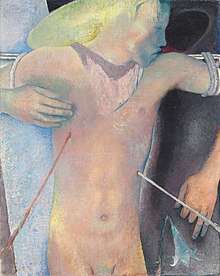
In the Roman Catholic Church, Sebastian is commemorated by an optional memorial on 20 January. In the Church of Greece, Sebastian's feast day is on 18 December. As a protector from the bubonic plague, Sebastian was formerly one of the Fourteen Holy Helpers. In Catholicism, Sebastian is the patron saint of archers, pin-makers, athletes (a modern association) and of a holy death.
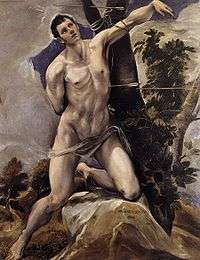
Sebastian is one of the patron saints of the city of Qormi in Malta along with Saint George.[38] Sebastian is the patron saint of Acireale, Caserta and Petilia Policastro in Italy, Melilli in Sicily, and San Sebastián as well as Palma de Mallorca, Lubrín and Huelva in Spain. He is the patron saint of Negombo, Sri Lanka and Rio de Janeiro, Brazil. Informally, in the tradition of the Afro-Brazilian syncretic religion Umbanda, Sebastian is often associated with Oxossi, especially in the state of Rio de Janeiro itself.
In Lubrín, every year on the 20th of January, there is a festival in honor of Saint Sebastian. A statue of Saint Sebastian leads a procession around the village, and people hurl bread rolls from their balconies to the crowds following the saint in the streets below. The rolls have a hole in the middle and some people string them on a rope around their body. The festival is thought to have originated in the 14th century, after a plague of cholera hit the area. At this time, the wealthy were said to have thrown bread and money to the poor on the streets below, so as to avoid catching the disease.[39] The San Sebastian 'bread festival' is so unusual that it has been declared a Fiesta of National Tourist Interest in Andalusia.[40]
Feast of St. Sebastian is celebrated among Catholic communities of Kerala in India, with lot of elegance and colour. Churches are grandiosely illuminated and decorated, with fireworks being a main event in every Catholic home to commemorate the saint. Every parish has its own date of celebration, especially in the districts of Thrissur, Ernakulam, St. Andrew's Basilica, Arthunkal and Kottayam. In Kanjoor Syro Malabar Church the feast is celebrated in a tremendous manner with the largest procession of Golden Crosses and Decorated umbrellas in Asia. Besides this, many pilgrim centres, churches, shrines and many educational institutions too, throughout Kerala, bear the name of the saint.
He is the patron of a college named for him in Manila, Philippines which is adjacent to the Parish of San Sebastian. At the Catholic Newman Community at the University of Rochester, the St. Sebastian Society is an organization of campus-wide Christian athletes that works to serve the greater Rochester, New York area through methods of restorative justice, special needs fundraising and community service.[41]
Sebastian is the patron saint of the Roman Catholic Diocese of Bacolod, in Negros Occidental, Philippines and Lipa City in Batangas, Philippines. Also, Saint Sebastian is the patron saint of Leon City Mexico. A representation of the Saint in his martyrdom is present in the upper left corner of the city coat of arms.
Saint Sebastian is the patron of Knights of Columbus Council #4926 in the Roman Catholic Diocese of San Jose in California, serving the cities of Mountain View and Los Altos. Saint Sebastian is the patron saint of the Catholic War Veterans of the United States of America. The highest award given by the CWV is the Honor Legion of the Order of St. Sebastian.
In his 1906 Reminiscences, Carl Schurz recalls the annual "bird shoot" pageant of the Rhenish town of Liblar (de), sponsored by the Saint Sebastian Society, a club of sharpshooters and their sponsors to which nearly every adult member of the town belonged.[42]
The St. Sebastian River in the American state of Florida is named after him. The river is a tributary of the Indian River Lagoon and comprises part of the boundary between Indian River County and Brevard County. The adjacent city of Sebastian, Florida and St. Sebastian River Preserve State Park are also named for Saint Sebastian.[43]
See also
- Le martyre de Saint Sébastien, Claude Debussy
- Saint Sebastian at the Column
- Santa Muerte, from Mexican folk Catholicism, who is sometimes referred to as Santa Sebastiana
- The three paintings by Mantegna
Notes
- "Urchin" here is the archaic English word for hedgehog, not a sea urchin. The original Latin uses the word "hericius",[10][11] not "echinus".[12]
References
- "How did St Sebastian become an enduring, homo-erotic icon?". The Independent. UK. 10 February 2008..
- Fr. Paolo O. Pirlo, SHMI (1997). "St. Sebastian". My First Book of Saints. Holy Mary Immaculate – Quality Catholic Publications. pp. 22–23. ISBN 971-91595-4-5.
- "About St Sebastian – Associated & Catholic Colleges of WA". www.accsport.asn.au. Retrieved 3 December 2017.
- White, Jackie. "The Patron Saint of Sports". Retrieved 3 December 2017.
- Hedquist, Valerie, "Ter Brugghen’s Saint Sebastian Tended by Irene," Journal of Historians of Netherlandish Art §8-9, 9:2 (Summer 2017) DOI: 10.5092/jhna.2017.9.2.3, fully online; The Vatican: The Metropolitan Museum of Art Guide, eds. Philippe De Montebello, Kathleen Howard, p. 347, 1983, Metropolitan Museum of Art, ISBN 0870993488, 9780870993480, google books
- Acta S. Sebastiani Martyris, in J.-P. Migne, Patrologiae Cursus Completus Accurante (Paris 1845), XVII, 1021–581221; abbreviated in Jacob de Voragine, Legenda Aurea.
- Brewer, Ebenezer Cobham. A Dictionary of Miracles: Imitative, Realistic, and Dogmatic (Chatto and Windus, 1901), p.11.
- Butler, Alban. Lives of the Fathers, Martyrs and Other Principal Saints, Vol.I},
- "Reliquary of St Sebastian". Metalwork. Victoria and Albert Museum. Retrieved 17 August 2007.
- "Iacobus de Voragine: Historia de Sancto Sebastiano". Retrieved 3 June 2016.
- "hericius definition | Latin Dictionary". Retrieved 3 June 2016.
- "echinus definition | Latin Dictionary". Retrieved 3 June 2016.
- "Internet History Sourcebooks: Medieval Sourcebook: The Golden Legend: Volume II: The Life of Sebastian". Retrieved 3 June 2016.
- City of Ebersberg website: Kloster Ebersberg (German)
- Thomas Foster Earle, K. J. P. Lowe: Black Africans in Renaissance Europe, p. 191, Cambridge University Press, 2005.
- "Saint Sebastian Interceding for the Plague Stricken". The Walters Art Museum.
- Mitchell
- The Iconography of Saint Sebastian: https://www.alessandro-giua.it/SEBASTIAN/
- "Catholic Encyclopedia". 1908. Cite journal requires
|journal=(help). - Barker, 94–95
- Barker, 96–97
- Boeckl, 76–80
- Barker, 114–7,Google books.
- Boeckl, p. 77
- Slive, Seymour, Dutch Painting, 1600–1800, Yale UP, 1995, ISBN 0300074514, p.22
- Barker, 117
- Zwingenberger, Jeanette (2011). Schiele. New York: Parkstone International. p. 154. ISBN 9781780421957.
- "Fabiola (1949)". BFI. Retrieved 3 December 2017.
- "Carrie (1976) – Trivia – IMDb". Retrieved 3 June 2016.
- "A Brutal Nobility: Painting Death in The House with Laughing Windows (Pupi Avati, 1976)". Retrieved 21 September 2016.
- Phillips, Gene D. (2013). Godfather: The Intimate Francis Ford Coppola. University Press of Kentucky. p. 134. ISBN 9780813146713.
- "Episode Synopsis". millennium-thisiswhoweare.net. Retrieved 6 April 2020.
- "Damien Hirst". MCA Denver. Archived from the original on 23 April 2010. Cite journal requires
|journal=(help). - Buchanan, Matthew. "Losing My Religion". Music Videos Love Movies. Retrieved 3 December 2017.
- Buckley, David (2002). R.E.M.: Fiction: An Alternative Biography. Virgin. pp. 206–07. ISBN 978-1-85227-927-1.
- notasfarwest (7 September 2015), The Mountain Goats - Hail St. Sebastian, retrieved 25 June 2017
- Doyle, John (4 September 2013). "Forgive Me: A fine, fraught new series about sinners". The Globe and Mail. Retrieved 22 September 2013.
- "Merħba – Parroċċa San Sebastjan". Parroċċa San Sebastjan. Retrieved 3 December 2017.
- "Municipio de Lubrin". www.puerta.lubrin.net. Retrieved 14 July 2019.
- "San Sebastián - Bread Festival - Official tourism website of Andalucía". www.andalucia.org. Retrieved 14 July 2019.
- St. Sebastian Society web page: http://urnewman.org/groups/st-sebastian
- Carl Schurz, Reminiscences (3 vols.), New York: McClure Publ., 1907, vol. 1, chap. 2, pp. 46–8; chap. 3, pp. 81–3.
- Sebastian Tales
Sources
- Barker, Sheila, The Making of a Plague Saint, ch. 4 in Piety and Plague: from Byzantium to the Baroque, Ed. Franco Mormando, Thomas Worcester Truman State University, 2007,ISBN 1-931112-73-8, ISBN 978-1-931112-73-4, Google books
- Boeckl, Christine M (2000). Images of Plague and Pestilence: Iconography and Iconology. Truman State University. pp. 76–80. ISBN 978-0-943549-85-9.
- Hedquist, Valerie, "Ter Brugghen’s Saint Sebastian Tended by Irene," Journal of Historians of Netherlandish Art 9:2 (Summer 2017) DOI: 10.5092/jhna.2017.9.2.3, fully online
- Mitchell, Peter, "The Politics of Morbidity: Plague Symbolism in Martyrdom and Medical Anatomy", in The Arts of 17th-Century Science: Representations of the Natural World in European and North American Culture, eds. Claire Jowitt, Diane Watt, 2002, Routledge, ISBN 9781351894449, google books
External links
- The Life and Martyrdom of St. Sebastian, Saint and Martyr of the Catholic Church
- Legenda Aurea: Life of Saint Sebastian
- Saint Sebastian
- Butler, The Lives or the Fathers, Martyrs and Other Principal Saints, St Sebastian
- Klemens Löffler (1913). . Catholic Encyclopedia.
- Chisholm, Hugh, ed. (1911). . Encyclopædia Britannica (11th ed.). Cambridge University Press.
- Representations of Saint Sebastian
